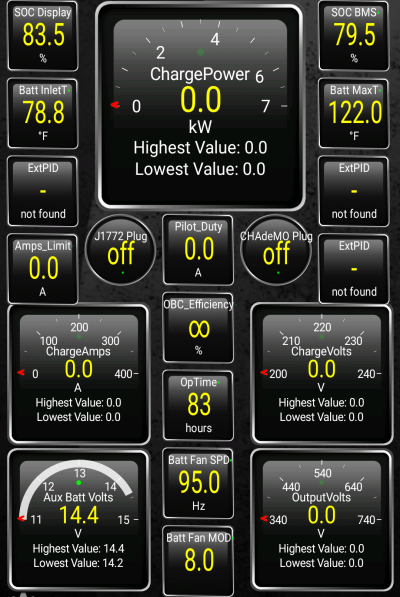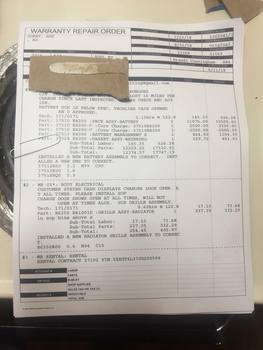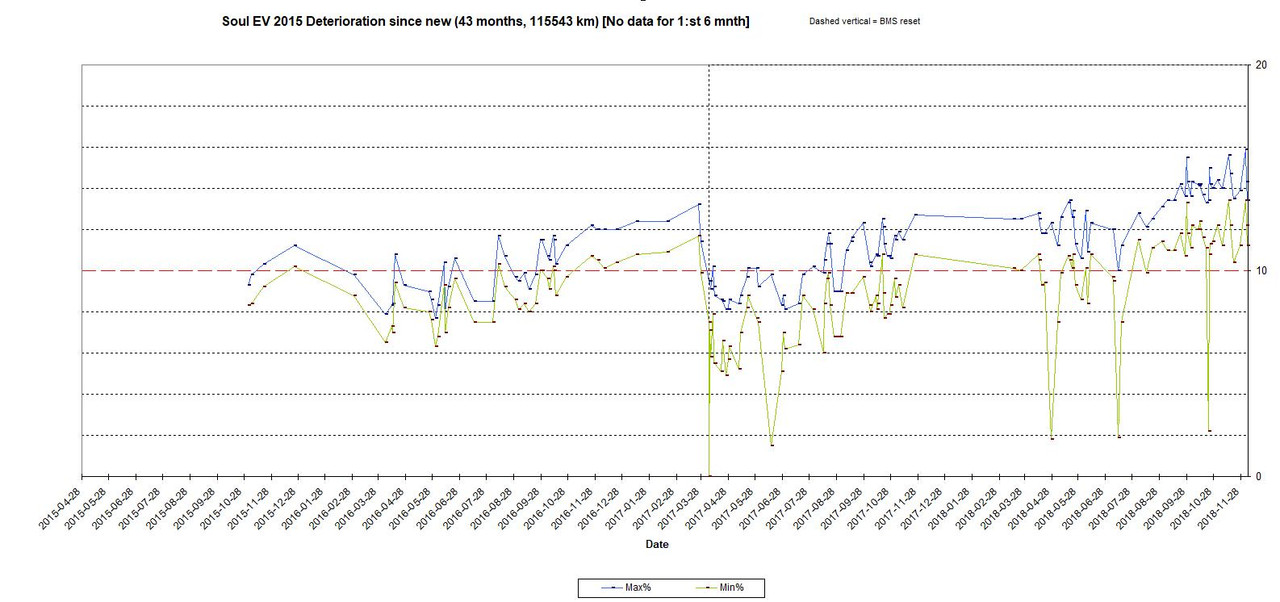-
I am going to compare the battery deterioration of Soul EVs in Quebec against the cars on Jeju Island.
It seems like cars in Quebec are suffering more deterioration.
As of August 1st 2018 there are 1,912 Soul Evs registered on Jeju Island.
As of June 30th 2018 there are 1,149 Soul Evs registered in Quebec.
Jeju Island has a much warmer climate than Quebec particularly in winter. Jeju Island does not get extreme heat or cold.
My car is 40 months old has driven 50,248km and is now at 99.2% SOH. A friend's car here has roughly the same stats.
My car was checked at Kia yesterday. The Torque data shows the exact same 99.2% as the official KDS.
The formula we use in Torque is 110 - (Max + Min) /2.
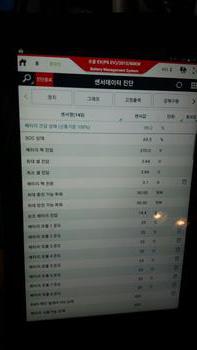
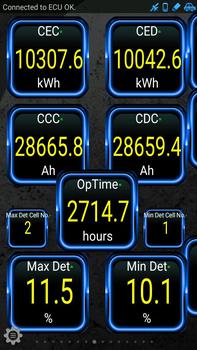
If my car represents an average car on Jeju then these cars will reach 70% deterioration after about 12 years and 180,000km.
I will not get a free battery replacement under warranty.
I chatted to the Kia tech at my local garage about deterioration. He guesses most cars here will need a battery replacement between 150,000km and 200,000km. He has had 1 car that came in with 150,000km and 68% SOH. Currently my garage does not have the equipment to do the replacements. They will buy it next year.
As reported earlier there was another car on the island that got a battery replacement.
From Jeju - MY2014 , 120,000 km, SOH at 58.2 % reported on :
Korean EV User Forum
The cars that are driven much further each day seem to deteriorate much faster than the average. ( In distance terms, obviously time wise it is much shorter)
------------------------------------------------
And now for Quebec. There's a facebook thread here discussing battery problems. :-
Quebec Soul EV Forum on Facebook
There seem to be many users reporting range loss and lower battery health.
Summarized by Siluzium -
So in summary :
Jonathan's Soul EV is a MY2015 with 75 000 km, owns it since December 2014. Mostly charges on L2, rarely on L3. On summer, consumption is aroung 14-16 kWh/100km. Range was 150-160km (summer 2015 and 2016), 130-140km (summer 2017), 120-130km (Spring 2018) and 100-110km (summer 2018). Official SOH reading at 91% this spring. Official reading on Aug 26 = 71.6%. Dealer says he has to wait until it drops below 70% to do something. He was wondering if it's normal degradation or not.
As I said in the comment in the tread, this is the kind of numbers that I am experiencing (however I'm currently around 130km on the highway — well, before vacations. I'll go to my parents tomorrow I'll let you know). GOM was at 189 I think when I received the car, and driving in the city and highway (100 km/h) we could get around 170 km at the beginning, in the summer. More like 145 km in 2016, 140 km in 2017, 130 km this year.
At the beginning, Nathanaël wonders why even in the first summer he couldn't get further, extrapolating theoretical driving range using 27 kWh as a base. Natanaël's Soul EV GOM was at 212 km at the beginning and could travel easily 190 km (note: I think it was probably in the city mostly). Summer consumption is around 11-13 kWh/100km.
Miriam's Soul EV has the same situation as Jonathan. She was waiting to drop below 70% as well.
Nicolas's Soul EV (he has the lowest VIN number I've seen, lives near me) is at 93.4%. He could do easily 160 km in 2016, now he can drive 125 km if he's careful.
Claude asked how Jonathan charged the car. Jonathan charges mostly on L2 as previously said. Before he was charging aroung 80% and 100%. Now he charges at 100%. Claude seems to imply that charging at 100% may accelere degradation.
François Morin also has similar numbers, MY2016 (a bit newer than mine), 70 000km. He says since the last BMS update, the last 15 km is more predictable (decreases more linearly than before).
Phil Duf (lives near me too), MY15 137 000 km SOH 64%, 80-90km range. His daily commute is 83 km. Under investigation during all summer, now turtle mode starts at 35 % SOC. Kia Canada is aware.
Jonathan asks what's the price of the Soul EV battery, no one really knows. Only reference I found is on KiaPartsNow website, and may not reflect the real price.
Guillaume Godbout got his battery changed, was below SOH 60%. One year later with the new battery SOH is still at 100%. He now avoids DCQC like hell, just in case. Philippe Tremblay wonders if it's a good thing that Soul EV charges so fast (read: unlike L eaf) no matter what, and if this could degrade the battery under some conditions.
Yvon's Soul EV can do about 130 km as well (MY16 titanium like us, a few months younger). Did a lot of QC, ~250.
Francois Boucher says that some battery degrade even if they dont do QC (like base models), so QC may not be the cause.
I have plenty of data from 1 car in Quebec. User Siluzium. 36 months old, 50,000km, SOH 92%
He is a regular user on the Quebec Forum and he thinks his car is average for his area.

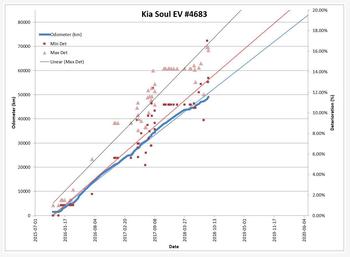
Here's a comparison of the data from my car and Siluzium's in Quebec.
My trend line in blue is above the warranty line in red, and seems to be getting better (new points are above - pushing my trend line up)
His trend line in green is belowthe warranty line in red, and seems to be getting worse (new points are below - pushing his trend line down)
Note the trend line in yellow is for the Phoenix cars. These cars die early in the extreme heat of the Arizona desert.
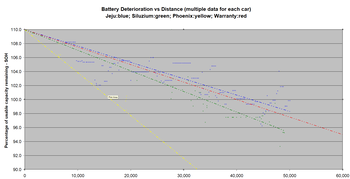
The big question is why? Why is Quebec doing worse than Jeju, when cold weather is supposedly good for battery longevity.
It would be great to have more data from Norway. That is the place with the most Soul EVs. But there is very little data.



































